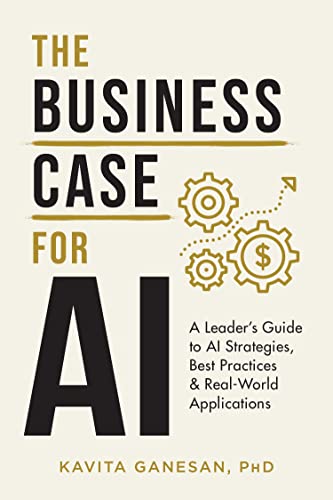Today we talk to Kavita Ganesan, author of The Business Case for AI: A Leaders Guide to AI
Strategies, Best Practices: Real-World Applications, she is an AI advisor, strategist, educator, and founder of
Opinosis Analytics. Kavita works with senior management and teams across the enterprise to help
them get results from AI.
With over 15 years of experience, Kavita has scaled and delivered
multiple successful AI initiatives for Fortune 500 companies as well as smaller organizations.
She has also helped leaders and practitioners around the world through her blog posts,
coaching sessions, and open-source tools. Today we talk to her about her new book and the role AI will have in business in the future.
Kavita Ganesan Founder of Opinosis Analytics
E-Crypto News
What role is artificial intelligence playing in today’s world? Please can you give us
examples?
AI currently plays a crucial role in information discovery (think Google), fraud detection, spam
prevention, handling simple customer support requests, and gaining deep insights from messy,
unstructured data.
Credit card companies, for example, rely heavily on AI for detecting fraudulent transactions. Google uses AI heavily
to rank search results, better understand user queries, and optimize advertising campaigns.
Why is AI important in business?
AI has the power to eliminate inefficiencies where human-level decision-making is required
while also providing opportunities for reducing human errors and boosting revenues.
Imagine how difficult and expensive it would be to manually process millions of credit card transactions
in real-time without AI.
Each transaction needs to be vetted on a case-by-case basis. Plus, you’d have to look at hundreds of different data points to
decide if a transaction was, in fact, fraudulent. The complexity of the task cannot be understated, but AI makes this process
extremely efficient.
What industries will AI change overnight?
Not overnight, but I do think AI can really shape the future of healthcare and online and offline
security systems and processes.
How has AI improved business operations in the United States? Please, can you provide
us with examples?
AI is currently a darling at tech companies in the US. It’s helped with targeted advertising,
product recommendations, spam reduction, and information discovery. Having said that, AI has
not made significant headway in other industries.
Companies currently benefitting from AI outside tech often find AI powerful in their customer service operations. Essentially, to answer
simple customer support queries or improve the efficiency of support operators in serving
customers.
A handful of manufacturing companies are evaluating the use of AI in improving
quality assurance in production lines.
What role has Opinosis Analytics played in the growth and development of the artificial
intelligence industry?
AI is often thought to be the job of the data scientist. However, without leadership involvement
and the right mindset at the management level, AI initiatives fail all the time. And it’s often not
because the problem was unsolvable, but more often than not, it’s management confusion.
Opinosis Analytics is working on changing this all too common situation by ensuring that both
leaders and practitioners have a common ground of AI understanding.
Leaders should know what promising AI opportunities look like, where these opportunities may exist, which initiatives
to invest in and which to shelf, how to prepare for AI, how to develop an AI strategy, and how to
measure the success of AI. Opinosis Analytics works with management teams at different
stages in their AI journey to answer many of these questions.
This can be in the form of hands-on consulting, providing training to address leadership knowledge gaps, or developing an AI
roadmap.
● Critics have postulated that AI will eliminate most blue-collar jobs. What are your
thoughts about this?
AI may eliminate some blue-collar jobs, but these are jobs that people may not enjoy doing
anyway. For example, not many workers will enjoy repetitively classifying if a credit card
transaction is fraudulent or not by looking at a hundred different data points over and over
again.
The task is tedious and mind-numbing and can eventually cause errors due to human
boredom and distractions. However, when assisted by AI, the amount of manual work
significantly goes down.
Another thing to keep in mind is that AI systems don’t operate in a
vacuum. They very much depend on human input for model training, model improvements, data
generation, and more. So, the “displaced” blue-collar workers may eventually become AI
supervisors and trainers.
● What are the moral questions businesses need to grapple with when it comes to AI and
its implementation?
There are several. One important topic is the propagation of societal biases. Since AI systems
learn by leveraging large amounts of data, societal and historical biases are often ingrained in
that data.
Using certain data sources for model training without careful consideration for the
types of biases it may contain can potentially propagate any bias present in that data. For
example, a large tech company had to once terminate the use of its AI recruiting tool as it was
disproportionately dismissing women candidates.
It turns out that the system learned from data
that male candidates were preferred—a reflection of male dominance in the tech field.
● What is the relationship between AI and robotics?
Robots can be just mechanical machines, performing repetitive movements with no real
intelligence. However, when you integrate AI into robots, you start having intelligent robots, that
can “see”, understand human commands, map out movement paths and do a whole lot more
than what mechanical machines alone can do. AI just makes robots behave and act more
“human.”
● How do AI models “think”?
AI models today learn by observing patterns in data. For example, if you want a model to learn
to predict if a credit card transaction is fraudulent or non-fraudulent, then you’d need thousands of examples of fraudulent and nonfraudulent transactions.
From these examples, a computer algorithm will learn what underlying pattern makes transactions fraudulent.
This is called model training where the “pattern finding” really happens. The trained model can then make
predictions on new transactions based on the patterns that it has learned and understood.
● What progress needs to be made for AI models to be Turing capable?
Do you mean to pass the Turing Test? Most likely significant progress in common sense
reasoning or the ability to build upon existing knowledge as humans can which is currently weak
in AI systems.
Also, there needs to be further improvement in language understanding, which
has already made significant progress in the last few years but I think more “in-depth”
understanding is required.
● How have AI learning techniques and processes improved over the past decade?
Most advancement in AI learning techniques over the last decade has centered around deep
learning (i.e. neural networks), specifically in language understanding.
Over the last few years, new neural network architectures which are more robust, with better learning capabilities have
emerged. As a result, large language models such as Open AI’s GPT models that can solve
various tasks and answer arbitrary questions have become possible.
● Other critics have postulated an Armageddon scenario for the world because of the rise of AI models and robots. What are your thoughts about such a scenario?
AI systems today are task-oriented machines. If you train these machines to
perform a series of tasks, they very well will.
But we must come to terms that AI systems today lack commonsense reasoning in a general sense, the ability
to effectively build upon knowledge, read between the lines, and use logic as
humans do.
While humans are born with such innate abilities, AI systems today rely heavily on patterns in data.
Even the famed GPT-3, the massive language prediction model that seems
to do everything, including completing computer source code, answering
questions, predicting sentiment, writing articles, etc, gets stumped when you
play with its “commonsense abilities”.
If one of the more sophisticated AI systems can’t answer basic questions that a two year old can, do you really
think AI robots can plan a complete takeover of the human race?
Nonetheless, this does not diminish the fact that task-oriented AI systems can
already enhance human lives in so many ways. I’ve written about this in detail
here.
● How Can the United States maintain its leadership in the AI and Robotics Industries?
What are the best ways and means of preventing intellectual property theft from rogue
nations?
It starts with government funding in AI & Robotics research — not just to
develop new techniques (which is where most of the funding happens to be) but to find novel ways of using AI and other related technologies to solve
pressing problems within the country such as inefficiencies in public transportation, detecting online and physical criminal activities, and preventing
external sources from hacking into our systems.
By investing heavily in such research, you cultivate new startups, open up relevant jobs, and strengthen
our AI position and abilities.
● Will AI models make humans either dumber or lazier? What are your thoughts about
this?
I think in some cases, it will make humans more complacent and assume that everything that
the AI is telling us is accurate. We see it clearly in the case of Meta, where algorithm-
recommended posts are by default thought to be accurate and reliable, leading to the great
spread of misinformation.
If only we paired our human judgment with those algorithm-
recommended posts, we might question the validity of posts coming from arbitrary sources with
questionable content.
Further, as algorithms continue to make our lives easier, we will become
more and more dependent on them to help solve the more tedious and menial tasks.
This can offload humans to tap more into their soft skills, solve more difficult challenges and explore their
creativity–which is a good thing.
● What steps can AI model developers take to prevent the growth and development of
rogue models that harm?
At this point in time, the AI systems are just doing what they’re tasked to do.
They’re not conscious machines aware of their actions. The harm really is in how humans choose to utilize the AI systems and how well the AI systems are
evaluated before release.
For example, you can take a simple AI application that can imitate someone’s voice to legally accuse them of saying something
that they didn’t. The evil was in the application of the AI tool.
Remember Tay, the Twitter bot that turned racist? It wasn’t racist because it wanted to be so, it was just imitating and repeating language the bot was
engaged with repeatedly on social media.
In this scenario, the problem wasn’t the bot, it was the lack of testing that went into it prior to the release of the bot.
● What are the various myths that surround artificial intelligence? How can such myths be
dispelled?
There are many really. One myth is that AI systems are plug-and-play type software that will
work flawlessly out of the box. The truth is, AI systems make mistakes all the time. If a model is
said to be 95% accurate, it can make mistakes 5% of the time, and that’s on data with which its
familiar.
On new data, the inaccuracies will be even higher. Another myth is that classical
machine learning techniques are inferior to deep learning techniques. This is not like the latest
iPhone, where the newest model is far superior to previous models.
AI techniques have been around for decades, and different approaches are suitable for different use cases and
constraints. If you can use a simple machine learning technique, which is accurate and
affordable to train and deploy, then there’s no use for deep learning techniques which can be
expensive to train.
Dispelling myths around AI starts with learning from trusted sources. There’s a lot of fluff around
AI and exaggeration of current capabilities.
Being able to do something in “research mode” doesn’t automatically mean that it’s ready for prime time in practical applications. So, learning
from trusted sources and experienced professionals is crucial.
Many of the articles you see online are written by marketing teams, ghostwriters, enthusiasts–essentially by people who
have never done AI. So you want to be careful where you’re consuming information.
● What ideas and insights can you give our readers on how best to implement artificial
intelligence models?
There are prepackaged solutions for common problems like predicting sentiment in texts or
translating languages. The key is to test various solutions and see which works for your specific
situation and on your data.
If you’re looking to build from scratch, you need good mastery of data science, machine learning, and maybe NLP. However, these days, with no code / low code
tools for AI development, you can develop models with a limited data science background.
However, I still feel you need proper mastery of data science to be able to make those tools
work for you for real-world applications.
To me, those tools are primarily time-savers once you have the foundational AI development knowledge.
● Just how much data is needed for AI learning models?
As much as it needs. Every problem is different. Some small problems can be solved
reasonably well with 500 rows of data. Some problems struggle with even 100 million rows of
data.
The quality and variety in data is much more important than the volume of data by itself.
Also, certain AI algorithms demand more data than others.
● When do you think Artificial Intelligence will become self-aware? Any takers?
The book of research hasn’t shown that AI is even as smart as a two-year-old in a general
sense. Common sense reasoning is still weak in AI systems.
So until there’s substantial progress in this area, I shall reserve my predictions.
● How are neural networks built? Please, can you provide us with some insight?
You can think of neural networks as a network of friends, each with a different set of expertise
receiving bits and pieces of information and sharing bits and pieces of “processed” information
with other friends about a particular problem.
This is so that you can make a correct decision to solve the problem at hand. In this network of friends, the final decision-maker takes in the final
bits and pieces of information which come from friends and friends of friends with varying levels
of trust and renders a decision.
To build this network using code, you often define how many friends you’d like to have, how
deeply your friends are networked, how they pass information to one another, and how many
friends should be ignored in training the network, etc.
Now, by repeatedly training this network with actual data that solves a real problem, the network will decide which friends to trust and
what their true expertise is. So when you run new unseen data through this trained network, it
will know what decision to render by leveraging this “expertise” network.
About Kavita
Kavita holds degrees from prestigious computer science programs, specifically a master’s
degree from the University of Southern California, and a Ph.D. from the University of Illinois at
Urbana Champaign, with a specialization in Applied AI, NLP, Search Technologies, and
Machine Learning.
Kavita has been featured by numerous media outlets including Forbes,
CEOWorld, CMSWire, Verizon, SD Times, Techopedia, and tED Magazine. To learn more
about Kavita, visit www.Kavita-Ganesan.com.
Short Bio:
Kavita Ganesan is the author of The Business Case for AI: A Leaders Guide to AI
Strategies, Best Practices & Real-World Applications and the founder of Opinosis Analytics, an
AI advisory and consulting company.
With over 15 years of experience in AI, Kavita holds a master’s degree from the University of Southern California, and a Ph.D. from the University of
Illinois at Urbana Champaign, with a specialization in Applied AI, NLP, Machine Learning, and
Search Technologies. Kavita has been featured in Forbes, CEOWorld, Verizon, CMSWire,
KDNuggets, SDTimes, and Yahoo Finance!







